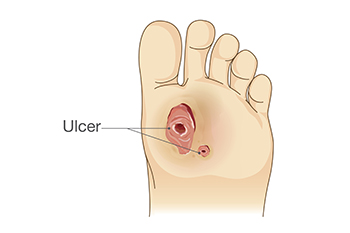
A diabetic foot ulcer is an open sore or wound that develops on the foot of a person with diabetes, often caused by poor circulation, nerve damage, or high blood sugar levels. These ulcers can lead to serious infections, if not treated promptly. Proper care includes keeping the wound clean, protecting it from pressure or friction, monitoring for signs of infection, and managing blood sugar levels. Symptoms include redness, swelling, discharge, or persistent pain. A podiatrist can help by evaluating the ulcer, providing specialized wound care, and recommending protective footwear or orthotics. This foot doctor can also develop a treatment plan to promote healing and prevent complications. If you have diabetes and have developed a foot ulcer, it is strongly suggested that you are under the care of a podiatrist who can help you to manage this serious condition.
Wound care is an important part in dealing with diabetes. If you have diabetes and a foot wound or would like more information about wound care for diabetics, consult with Yvonne Umezurike, DPM from Umez Podiatry. Our doctor will assess your condition and provide you with quality foot and ankle treatment.
What Is Wound Care?
Wound care is the practice of taking proper care of a wound. This can range from the smallest to the largest of wounds. While everyone can benefit from proper wound care, it is much more important for diabetics. Diabetics often suffer from poor blood circulation which causes wounds to heal much slower than they would in a non-diabetic.
What Is the Importance of Wound Care?
While it may not seem apparent with small ulcers on the foot, for diabetics, any size ulcer can become infected. Diabetics often also suffer from neuropathy, or nerve loss. This means they might not even feel when they have an ulcer on their foot. If the wound becomes severely infected, amputation may be necessary. Therefore, it is of the upmost importance to properly care for any and all foot wounds.
How to Care for Wounds
The best way to care for foot wounds is to prevent them. For diabetics, this means daily inspections of the feet for any signs of abnormalities or ulcers. It is also recommended to see a podiatrist several times a year for a foot inspection. If you do have an ulcer, run the wound under water to clear dirt from the wound; then apply antibiotic ointment to the wound and cover with a bandage. Bandages should be changed daily and keeping pressure off the wound is smart. It is advised to see a podiatrist, who can keep an eye on it.
If you have any questions please contact our offices located in Baltimore, MD and Washington DC . We offer the newest diagnostic and treatment technologies for all your foot and ankle needs.
The medical procedure that is referred to as shockwave therapy may be beneficial in reducing the pain that is associated with plantar fasciitis, heel spurs, and discomfort from an Achilles tendon injury. It is applied through the surface of the skin, and is known to accelerate the healing process as blood vessels are repaired. The benefits of this type of treatment can include a speedy recovery, no anesthesia, and that the procedure is simple to apply. If you suffer from chronic foot pain, and would like additional information about shockwave therapy, it is suggested that you schedule an appointment with a podiatrist who can determine if this is the correct treatment for you.
Shockwave therapy is a treatment commonly used to treat various injuries and conditions, particularly plantar fasciitis in the feet. To learn more, consult with Yvonne Umezurike, DPM from Umez Podiatry. Our doctor can provide the care you need to keep you pain-free and on your feet.
Shockwave Therapy
Shockwave therapy is a new treatment option designed to treat bone conditions such as tennis elbow, shoulder pain, and others. Shockwave therapy uses high intensity sound waves that are directed to the affected tissues of the body with pinpoint accuracy. The effects are very beneficial, leading to a production of collagen fibers, eliminating inflammation.
Who Benefits from Shockwave?
Shockwave is recommended for patients suffering from heel pain and associated problems. Heel pain is a common condition which can be caused by obesity, overexertion, and spending a substantial amount of time on hard floors with your feet exposed and unsupported.
Fast and Easy
The therapy is actually a simple process that can leave patients feeling better the very next day. Shockwave therapy is not as dramatic as it sounds. It enables more blood flow to effected areas, addressing the source of the problem and allowing treatment to last for a long time.
Treatment & Recovery Time
Shockwave treatment will enable your feet to recover quickly. This is especially important since surgery is not required. It is cost effective and does not require the use of anesthesia. This treatment is a better option to surgery, since it is proven safe.
If you have any questions, please feel free to contact our offices located in Baltimore, MD and Washington DC . We offer the newest diagnostic and treatment technologies for all your foot care needs.

A good running shoe provides proper cushioning to absorb impact, breathable materials to keep feet dry and comfortable, and a design that balances style with performance. Proper fit is essential, as shoes that are too tight or too loose can cause blisters, calluses, plantar fasciitis, or joint pain. Foot alignment and gait are also important considerations for injury prevention. A podiatrist can assess your foot structure, recommend shoes that match your biomechanics, and provide orthotics or supportive modifications, if needed. Investing in the right running shoes and professional guidance ensures comfort, improves performance, and protects your long-term foot health. If you have foot pain from wearing the wrong type of shoes, it is suggested that you consult a podiatrist who can treat various foot conditions, and guide you on additional qualities to look for in running shoes.
You should always make sure your running shoes fit properly in order to avoid injury. For more information, contact Yvonne Umezurike, DPM from Umez Podiatry. Our doctor can provide the care you need to keep you pain-free and on your feet.
Choosing the Right Running Shoe for Your Foot Type
Improper shoe sizing can cause a myriad of problems for your feet. Shoes that don’t fit you properly can lead to muscular imbalances in your body, which can result in foot, knee, and hip injuries.
Tips for Finding the Right Running Shoe
- Make sure you have a thumb’s width of wiggle room between the end of your longest toe and the front of the shoe.
- There should be little to no slipping at the heel
- Don’t assume your size in one shoe brand will be your size in another
- Do not lace up your shoes too tightly
- Walk around in the store with your new shoes before you buy them
If you have any questions, please feel free to contact our offices located in Baltimore, MD and Washington DC . We offer the newest diagnostic and treatment technologies for all your foot care needs.





